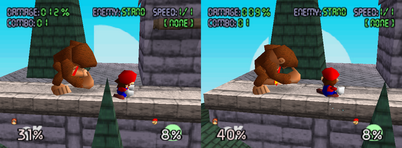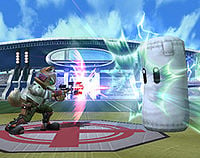Stale-move negation: Difference between revisions
No edit summary |
|||
| Line 3: | Line 3: | ||
'''Stale-move negation''' is a gameplay element in the [[Super Smash Bros. (series)|''Super Smash Bros.'' series]]. It refers to how moves cause less damage as they are used repeatedly. | '''Stale-move negation''' is a gameplay element in the [[Super Smash Bros. (series)|''Super Smash Bros.'' series]]. It refers to how moves cause less damage as they are used repeatedly. | ||
[[Masahiro Sakurai]] added stale move negation to the ''Super Smash Bros.'' series in order to encourage players to try different attacks out and use characters to their fullest instead of using a move repeatedly. When a character uses an attack repeatedly, the [[damage]] and [[knockback]] goes down until it becomes less than half its original power. Using different attacks will reset the damage of the used attack at about the same rate it was cut, while being [[KO|KO'd]] resets all a character's moves (except in ''[[Super Smash Bros.]]''). | [[Masahiro Sakurai]] added stale move negation to the ''Super Smash Bros.'' series in order to encourage players to try different attacks out and use characters to their fullest instead of using a move repeatedly. When a character uses an attack repeatedly, the [[damage]] and [[knockback]] goes down until it becomes less than half its original power. Using different attacks will reset the damage of the used attack at about the same rate it was cut, while being [[KO|KO'd]] resets all of a character's moves (except in ''[[Super Smash Bros.]]''). | ||
In ''[[Super Smash Bros. Brawl]]'', the effect of stale move negation affects damage for all moves (and therefore knockback, as damage dealt is an important factor in the calculation). Stale move negation does exist in the previous two games, but its effect is much less drastic and recognisable outside of the Stale Moves bonus in ''[[Melee]]'' (worth -2000) and the Cheap Shot bonus in ''Super Smash Bros.'' (worth -99), due to there being almost no reduction in knockback. | In ''[[Super Smash Bros. Brawl]]'', the effect of stale move negation affects damage for all moves (and therefore knockback, as damage dealt is an important factor in the calculation). Stale move negation does exist in the previous two games, but its effect is much less drastic and recognisable outside of the Stale Moves bonus in ''[[Melee]]'' (worth -2000) and the Cheap Shot bonus in ''Super Smash Bros.'' (worth -99), due to there being almost no reduction in knockback. | ||
Revision as of 15:18, September 26, 2011

Stale-move negation is a gameplay element in the Super Smash Bros. series. It refers to how moves cause less damage as they are used repeatedly.
Masahiro Sakurai added stale move negation to the Super Smash Bros. series in order to encourage players to try different attacks out and use characters to their fullest instead of using a move repeatedly. When a character uses an attack repeatedly, the damage and knockback goes down until it becomes less than half its original power. Using different attacks will reset the damage of the used attack at about the same rate it was cut, while being KO'd resets all of a character's moves (except in Super Smash Bros.).
In Super Smash Bros. Brawl, the effect of stale move negation affects damage for all moves (and therefore knockback, as damage dealt is an important factor in the calculation). Stale move negation does exist in the previous two games, but its effect is much less drastic and recognisable outside of the Stale Moves bonus in Melee (worth -2000) and the Cheap Shot bonus in Super Smash Bros. (worth -99), due to there being almost no reduction in knockback.
Moves that are counter-attacks or absorbers do not take the stale move negation of the incoming attack into consideration. Items are also affected by stale move negation, even if the player drops the item they're holding and pick up a different one of the same.
Calculation

In Brawl, stale move negation is calculated with the aid of a queue of the last ten moves a character has connected with. When a move is used that's in the queue, its damage is decreased an amount based on both how often the move is in the queue and how recently the move has been used. If a move is used ten times in a row, it will have lost 55% of its power in total. If a move is not in the list of ten most recently-used moves, it earns a freshness bonus of 1.05x damage - therefore, in Brawl, very few attacks ever deal the exact damage they are programmed to do.
Testing to determine the stale move negation effect in Brawl initially confused players, as the effect is not applied in Brawl's Training Mode (the confusion stemming from the fact that is was applied in the training modes of Super Smash Bros. and Melee). This is due to the fact that stale move negation is not applied in any of the 1P modes in Brawl, except for in the Home-Run Contest.
An important note is that stale move negation is applied to the whole attack rather than individual hitboxes. As such, landing the weak hitbox will weaken all hitboxes in the attack just as landing the strongest hitbox would.
An interesting quirk of stale-move negation in Brawl is how it acts if an attack's ending lag is interrupted by another instance of the same attack - the move is put unto the queue for each time it hits, but the attack doesn't decrease in damage until the character enters a different action. For example, multiple quick hits of Meta Knight or Marth's down tilt will all deal maximum damage if initiated during the cooldown of the previous one, not decreasing in damage until the chain ends and the character enters their crouching or standing state.
Controversy
The much more severe stale move negation in Brawl has had a mixed reception among the competitive fanbase. Those who support the severe stale move negation argue that it adds more strategy and depth to the game, giving importance to "saving finishers" until the opponent is in the KO range, while rewarding those who plan the use of their attacks appropriately, and punishing those who rely on their KO attacks to rack up damage. Detractors argue that it allows some attacks to combo into themselves much more effectively than they should, resulting in them being overly powerful damage rackers at low percents. This has been the primary cause of some hard counter matchups, with the most notorious examples of such attacks being Pikachu's down throw and Sheik's forward tilt.
Some mods of Brawl, with the developers having the sentiment of the detractors, alter stale move negation; some reduce its powers to varying degrees, while others remove it altogether.
Moves that stale-move negation does not affect
The following moves are not affected by stale-move negation:
- Recoil damaging moves (Roy's fully charged Flare Blade, and Pichu's electric attacks, for instance)
- Donkey Kong's cargo throw always does 10% to his victim
- The Clawshot used in midair (always 4% first hit, 6% second hit if spaced correctly)
- The Hookshot used in midair (always 4%)
- The Grapple Beam used in midair (always 4%, always 7% if tipped)
- Zero Suit Samus' neutral air (always 10%)
- Luigi's down taunt (always 1% in Super Smash Bros. and Melee, always 2% in Brawl)
- Snake's Hand Grenade's explosion (always 12%-13%)